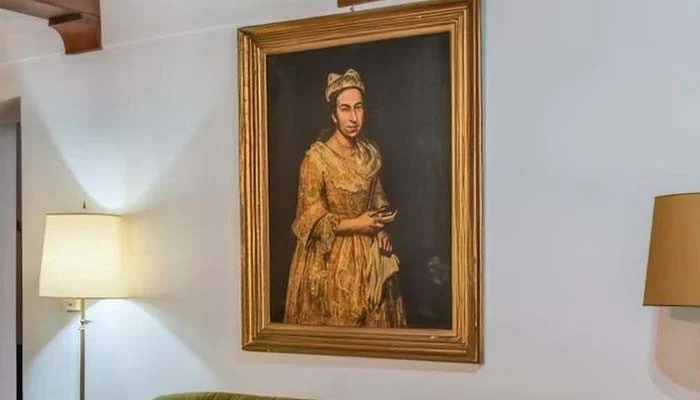- The Story of the Portrait of a Lady
- The Real Estate Listing That Sparked the Discovery
- Argentina’s Shadowed History with Nazi Loot
- The Global Scale of Nazi Art Looting
- The Process of Authenticating and Reclaiming the Painting
- Why This Discovery Matters
- Expert Opinions on the Discovery
- The Role of Public Awareness in Art Restitution
- FAQs
- What is the Portrait of a Lady painting?
- How was the painting discovered in Argentina?
- Why did Nazis loot so much art during World War II?
- What happens to recovered Nazi-looted art?
- Are many Nazi-looted artworks still missing?
- Conclusion
Art has always been more than just brushstrokes on canvas—it carries history, culture, identity, and often, unresolved mysteries. Among the countless stories of lost masterpieces, few resonate as powerfully as those tied to the looted treasures of World War II. One such case has resurfaced with the remarkable discovery of a Nazi-looted Italian painting, “Portrait of a Lady”, found in Argentina after decades of obscurity. The recovery was not the result of high-tech investigations or sophisticated heists but rather a simple real estate listing tip, proving that history sometimes resurfaces in the most unexpected ways. This discovery not only reignites discussions about Nazi-era art theft but also highlights the ongoing struggle for justice, restitution, and historical accountability in the art world.
The painting, once thought lost to the chaos of war, holds a story intertwined with European history, family legacy, and the persistence of art historians. Its resurfacing thousands of miles from its homeland invites questions about how stolen cultural treasures travel, why they remain hidden for so long, and what their recovery means for future generations.
The Story of the Portrait of a Lady
The painting in question, “Portrait of a Lady”, is attributed to an Italian master and is valued not only for its artistic brilliance but also for its cultural symbolism. Created during the Italian Renaissance period, the work reflects the delicate interplay of light, color, and human expression that defined the era. The subject—a noblewoman whose identity remains uncertain—embodies the elegance and societal prestige of Italy’s aristocracy.
Like many masterpieces, its fate was dramatically altered during World War II. The Nazis orchestrated one of the most systematic campaigns of art theft in history, seizing works across occupied Europe. These looted works were often destined for Adolf Hitler’s envisioned Führermuseum in Linz, Austria, or for private collections of Nazi officials. Millions of pieces were taken, ranging from priceless paintings to sacred manuscripts, sculptures, and even everyday cultural artifacts.
The Portrait of a Lady disappeared amid this wave of theft, presumed destroyed or permanently hidden. For decades, its trail went cold, becoming one of countless “lost” artworks cataloged by art recovery experts. That is, until an Argentinian real estate listing unexpectedly brought it back into the public eye.
The Real Estate Listing That Sparked the Discovery
The resurfacing of the painting is almost cinematic in nature. A prospective buyer in Buenos Aires came across the Portrait of a Lady while browsing through property listings. It was casually displayed in the background of photographs advertising a luxurious estate for sale. The buyer, with a keen interest in art, recognized something unusual about the portrait and tipped off local authorities.
From there, art historians and experts were brought in to verify the painting’s authenticity. Through careful examination of brushwork, pigments, and stylistic elements, they confirmed the piece was indeed the long-missing Portrait of a Lady. The confirmation stunned the art world, not only because of the painting’s unexpected location but also because it raised new questions about how the work had traveled from wartime Europe to South America.
Argentina’s Shadowed History with Nazi Loot
The discovery of the painting in Argentina is not as improbable as it may seem at first glance. After World War II, Argentina became a well-known refuge for Nazi officials and sympathizers. Historical research shows that thousands of former Nazis fled to the country using clandestine escape routes known as “ratlines.” Many brought with them stolen wealth, gold, and cultural treasures.
South America’s art market became an informal repository for such objects, and families of Nazi émigrés often retained these items without fully disclosing their origins. The Portrait of a Lady could very well have been smuggled into Argentina during this period, safeguarded for decades by descendants or collectors who either ignored or concealed its dark provenance.
This discovery underscores how Nazi-looted art often remains hidden in private hands, far from the galleries and museums where it rightfully belongs. Experts estimate that more than 100,000 pieces of stolen art are still unaccounted for worldwide. Each recovered artwork represents not only a historical correction but also an emotional victory for the families and nations stripped of their cultural heritage.
The Global Scale of Nazi Art Looting
The Nazis’ systematic plundering of art was unparalleled in scope. Between 1933 and 1945, it is estimated that they looted over 650,000 works of art across Europe. Entire collections were dismantled, particularly from Jewish families who were persecuted and stripped of their possessions. These works were transported, cataloged, and dispersed through official institutions or private hoards.
Many works were destroyed in the chaos of war, while others disappeared into black markets and private collections. High-profile recoveries, such as Gustav Klimt’s Portrait of Adele Bloch-Bauer or Leonardo da Vinci’s Lady with an Ermine, have captured international attention, but thousands more remain lost. The Portrait of a Lady joins this select list of rediscovered treasures, shedding light on the broader issue of unresolved art restitution.
The Process of Authenticating and Reclaiming the Painting
Authentication is one of the most challenging aspects of art recovery. Experts analyzing the Portrait of a Lady used advanced imaging techniques, pigment analysis, and historical archives to confirm its identity. Records from wartime Europe indicated its disappearance, while comparison with earlier photographs and catalogues provided conclusive evidence.
Once verified, the question turned to rightful ownership. Should the painting be returned to Italy? Should it belong to the heirs of its pre-war owners, if any can be identified? These legal and ethical dilemmas remain central to Nazi-looted art cases. International agreements, such as the 1998 Washington Principles on Nazi-Confiscated Art, stress the importance of restitution, but each case presents unique complexities.
Why This Discovery Matters
The significance of the Portrait of a Lady discovery goes beyond art history. It symbolizes the resilience of culture against oppression, the possibility of justice delayed but not denied, and the enduring value of vigilance.
It also reflects the growing role of technology and public participation in art recovery. In this case, a simple property listing became the unlikely clue that cracked open a decades-long mystery. It demonstrates that art is not confined to museums—it lives in homes, estates, and private spaces, often carrying hidden stories waiting to be uncovered.
For Italy, the painting’s recovery represents a reclaiming of cultural pride. For the global art community, it is a reminder that the work of restitution is far from complete. And for the public, it provides a fascinating story that blends history, crime, and human resilience.
Expert Opinions on the Discovery
Art recovery specialists and historians have weighed in on the discovery with a mix of astonishment and optimism. According to Dr. James Snyder, an art restitution expert, “Every time a Nazi-looted artwork surfaces, it reopens wounds but also provides healing. It’s proof that justice can still be pursued, even generations later.”
Meanwhile, Italian cultural ministerial representatives have expressed determination to ensure the painting’s rightful restitution. They have pledged to cooperate with Argentine authorities and international bodies to trace ownership and finalize its return.
The Role of Public Awareness in Art Restitution
One of the lessons from this case is the crucial role of public awareness. The real estate tip only worked because someone recognized the painting. Raising awareness about lost art can mobilize ordinary citizens to notice what experts may overlook.
Initiatives such as online databases of looted art, museum exhibitions on restitution, and educational campaigns are all essential in bridging the gap between past crimes and present accountability. Each rediscovery, like that of the Portrait of a Lady, helps build momentum for other recoveries still waiting to happen.
FAQs
What is the Portrait of a Lady painting?
The Portrait of a Lady is an Italian Renaissance painting depicting an unknown noblewoman. It gained historical significance after being looted by the Nazis during World War II and thought lost for decades until its recent rediscovery in Argentina.
How was the painting discovered in Argentina?
The painting was spotted in the background of a real estate listing for a luxury estate in Buenos Aires. A potential buyer recognized its significance and tipped off authorities, leading to expert verification and recovery.
Why did Nazis loot so much art during World War II?
The Nazis looted art to fund their regime, enrich their leaders, and to build Hitler’s planned “Führermuseum.” The plunder was also an ideological act, erasing Jewish cultural heritage and consolidating German dominance over European culture.
What happens to recovered Nazi-looted art?
Recovered art typically undergoes authentication and ownership tracing. Depending on legal and ethical findings, it may be returned to its original owners’ descendants, repatriated to its country of origin, or placed in public museums.
Are many Nazi-looted artworks still missing?
Yes. Experts estimate over 100,000 pieces remain missing worldwide. While some are hidden in private collections, others may have been destroyed. International efforts continue to recover and restitute these works.
Conclusion
The rediscovery of the Nazi-looted Italian painting Portrait of a Lady in Argentina is more than a remarkable art story—it is a reminder of the unfinished business of history. It shows how cultural treasures, even when buried under decades of secrecy, can reemerge through chance and persistence. This painting’s journey from Renaissance Italy to wartime plunder, to South American exile, and finally to rediscovery exemplifies the resilience of truth.
Each recovery chips away at the vast puzzle of Nazi art theft, restoring not only objects but also fragments of collective memory. As long as such treasures remain hidden, the work is not done. The Portrait of a Lady stands today not only as a beautiful Renaissance artwork but as a symbol of justice reclaimed, history illuminated, and culture triumphing over tyranny.











